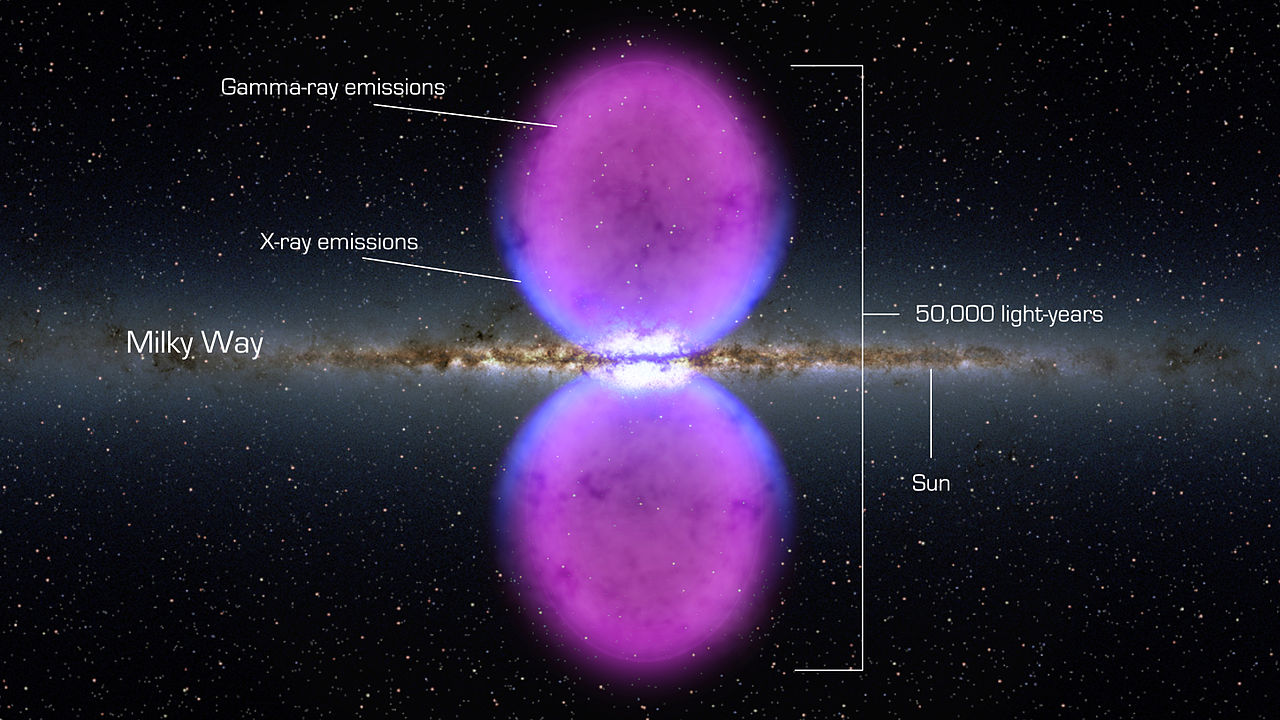

Wow! How come nobody told me about the 'Fermi bubbles'? If you could see gamma rays, you'd see enormous faint glowing bubbles extending above and below the plane of the Milky Way.
Even better, nobody is sure what produced them! I love a mystery like this.
The obvious suspect is the black hole at the center of our galaxy. Right now it's too quiet to make these things. But maybe it shot out powerful jets earlier, as it swallowed some stars.
Another theory is that the Fermi bubbles were made by supernova explosions near the center of the Milky Way. But active galactic nuclei — where the central black hole is eating a lot of stars — often have jets shooting out in both directions. So I'm hoping something like that made the Fermi bubbles. Computer models say jets lasting about 100,000 years about 2.6 million years ago could have done the job.
The Fermi bubbles were discovered in 2010 by the Fermi satellite: that's how they got their name. I learned about them by reading this review article:
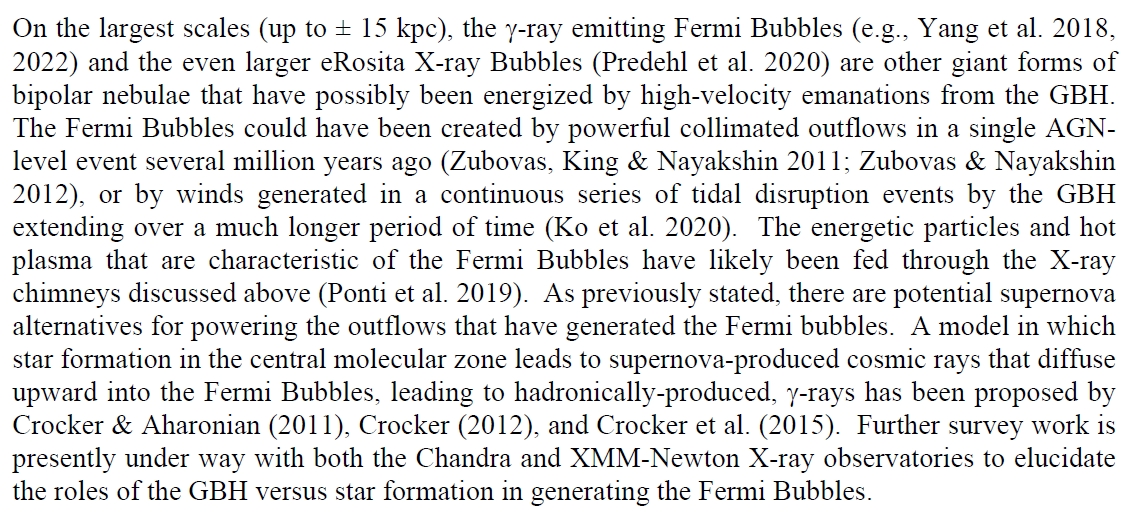
Another cool thing: we may have detected some neutrinos emanating from the Fermi bubbles! These neutrinos have energies between 18 and 1,000 TeV. That's energetic! Our best particle accelerator, the Large Hadron Collider, collides protons with an energy of about 14 TeV. This suggests that the Fermi bubbles contain a lot of very high-energy protons — so-called 'cosmic rays' — which occasionally collide.
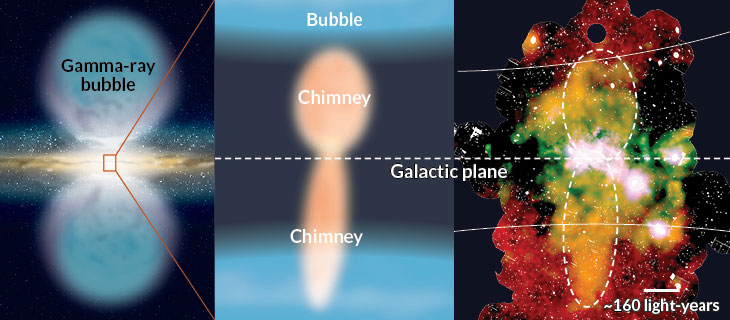
First astronomers discovered enormous gamma-ray-emitting bubbles above and below the galactic plane — the 'Fermi bubbles' I wrote about last time.
Then they found 'X-ray chimneys' connecting these bubbles to the center of the Milky Way!
These X-ray chimneys are about 500 light-years tall. That's huge, but tiny compared to the Fermi bubbles, which are 25,000 light years across. They may have been produced by the black hole at the center of the Galaxy. We're not completely sure yet.
Here's an X-ray image taken by the satellite XMM-Newton in 2019. It clearly shows the X-ray chimneys:
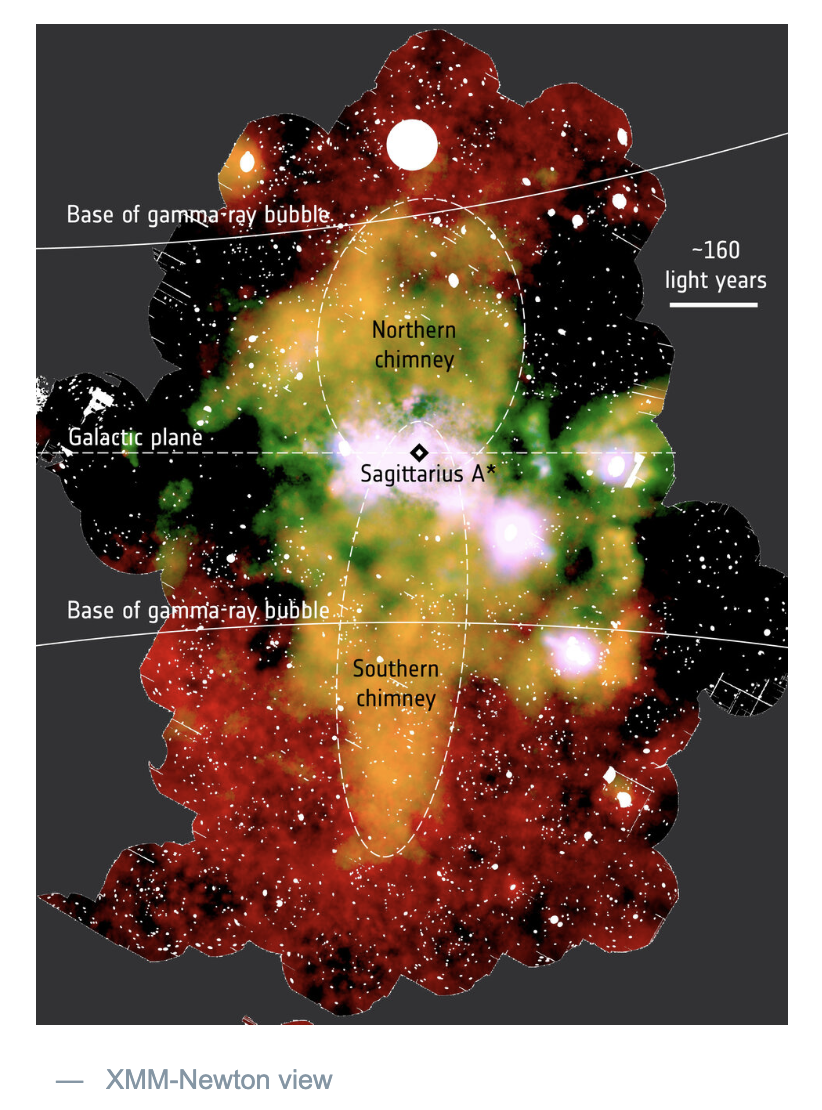
Sagittarius A* is the black hole at the center of our galaxy. It's an obvious suspect for what created these chimneys!
Puzzle. What's the white circle?
For the answer, go to my March 2 diary entry. And for more on the X-ray chimneys, try this:
Abstract. Evidence has increasingly mounted in recent decades that outflows of matter and energy from the central parsecs of our Galaxy have shaped the observed structure of the Milky Way on a variety of larger scales. On scales of ~15 pc, the Galactic centre has bipolar lobes that can be seen in both X-rays and radio, indicating broadly collimated outflows from the centre, directed perpendicular to the Galactic plane. On far larger scales approaching the size of the Galaxy itself, gamma-ray observations have identified the so-called Fermi Bubble features, implying that our Galactic centre has, or has recently had, a period of active energy release leading to a production of relativistic particles that now populate huge cavities on both sides of the Galactic plane. The X-ray maps from the ROSAT all-sky survey show that the edges of these cavities close to the Galactic plane are bright in X-rays. At intermediate scales (~150 pc), radio astronomers have found the Galactic Centre Lobe, an apparent bubble of emission seen only at positive Galactic latitudes, but again indicative of energy injection from near the Galactic centre. Here we report the discovery of prominent X-ray structures on these intermediate (hundred-parsec) scales above and below the plane, which appear to connect the Galactic centre region to the Fermi bubbles. We propose that these newly-discovered structures, which we term the Galactic Centre Chimneys, constitute a channel through which energy and mass, injected by a quasi-continuous train of episodic events at the Galactic centre, are transported from the central parsecs to the base of the Fermi bubbles.
Let's look at an example. The natural numbers come from finite sets. Two finite sets are isomorphic iff they have the same number of elements. So, natural numbers are isomorphism classes of finite sets. And addition and multiplication of natural numbers come from operations in the category of finite sets, called coproduct and product.
So this rig, at least, comes from a category!
But the natural numbers also come from finite-dimensional vector spaces. Two such vector spaces are isomorphic iff they have the same dimension, which is a natural number. And additions and multiplication of natural numbers come from operations in the category of finite-dimensional vector spaces, called direct sum \(\oplus\) and tensor product \(\otimes\).
Indeed, there are lots of familiar categories that give rigs in this way. They have a way to add objects and also a way to multiply them.
In the early 1970s, Kelly and Laplaza formalized what's going on here, by introducing 'rig categories' (which they called ring categories). Their axioms relating \(\oplus\) and \(\otimes\) were complicated, because all the usual rig axioms hold only up to isomorphism, like $$ a \otimes (b \oplus c) \cong (a \otimes b) \oplus (a \otimes c) $$ and these isomorphisms need to make a bunch of diagrams commute. That is, a bunch of diagrams do commute in all the examples that matter, so if they didn't it would seem weird.
I conjectured that the groupoid of finite sets and bijections is the 'weakly initial' rig category. In other words, it maps to every other rig category in a way that's unique up to natural isomorphism:
My conjecture was proved in 2004 by Josep Elgueta. The proof was complicated. In fact, it had a mistake! Elgueta fixed it in 2020:
Also in 2020, these authors developed a way to draw morphisms in rig categories:I'm curious to know how rigorous it is. Often diagrams like this give arguments that are easier to understand, but harder to make 100% rigorous. (That's okay with me, I'm not a hardass. It's just interesting.)
All this goes to show that even a seemingly simple thing like the natural numbers holds hidden depths.
Well, the whole saga of mathematics leading up to the undecidability and imcompleteness of Peano arithmetic also shows that the natural numbers are far from simple. But I'm saying that even the basic axioms for + and × become subtler when you realize that equations summarize isomorphisms!
I'm working on rig categories with Joe Moeller and Todd Trimble now. But we're focused on a very special kind of rig category, which we call a '2-rig' purely for the sake of brevity. These show up in representation theory, K-theory and other branches of math with a strong 'linear algebra' flavor. For example the category of finite-dimensional vector spaces is a 2-rig, but not the category of finite sets.
We wrote one paper about this:
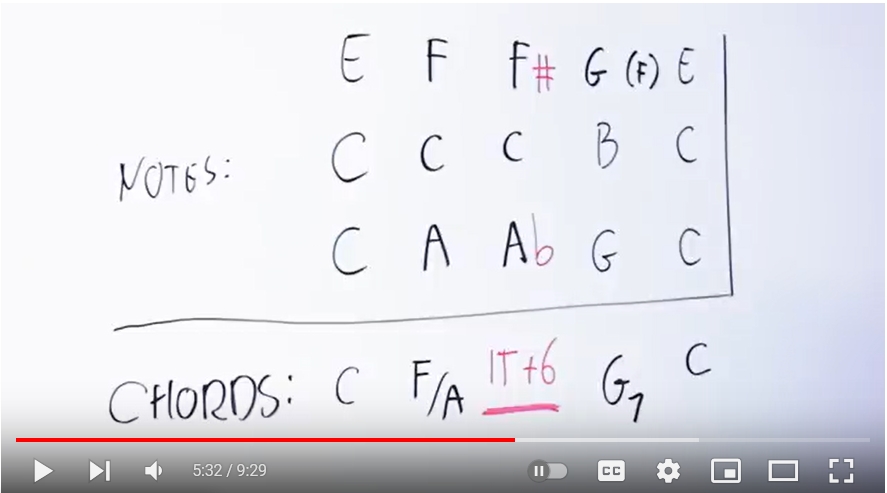
But she had a complaint: where the chords finally resolve to a C major triad, he writes the final chord as CCE — but those first two notes don't sound like they're an octave apart!
And she was right! Here's the video:
Just for my own sake, let me explain how an Italian 6th works.
Zillio explains it in the key of C but I prefer numbers. One of the big motors that drives classical music is the progression
IVfrom IV, called the 'subdominant', to V, called the 'dominant', to I, called the 'tonic'. Tension followed by release! If we write these chords as triads they are
V
I
IV = 4 6 8But we'd probably invert these chords for good voice leading: we don't want notes making big jumps.
V = 5 7 9
I = 1 3 5
Most importantly, the 7 wants to climb up to the 8, which is one octave higher than the 1. Also, the 9 would be happy to climb up to the 10 — which is an octave higher than the 3. So let's raise the 1 and 3 an octave and get 8 and 10:
IV = 4 6 8Since we've raised two notes, now we say the I is in 'second inversion'.
V = 5 7 9
I = 5 8 10
Next: people like to heighten the tension of the V by adding an extra note and getting a 7th chord, called V7 or the 'dominant 7th':
IV = 4 6 8This is an incredibly common chord progression, often decorated in various ways. Indeed, the music theorist Richard Goldman wrote:
V7 = 5 7 9 11
I = 5 8 10
The demand of the V7 for resolution is, to our ears, almost inescapably compelling. The dominant seventh is, in fact, the central propulsive force in our music; it is unambiguous and unequivocal.Next, we could invert the IV chord by pushing the 4 up an octave to get 11:
IV = 6 8 11
V7 = 5 7 9 11
I = 5 8 10
Now the 11 just sits there for the first two chords. We could get a cooler sound by sharping that 11:
IV#° = 6 8 11#The first chord is more fancy now: it's called a 'diminished sharp IV in first inversion'. (A IV chord is 4 6 8. If we push up the 4 by a half-tone we get 4# 6 8: now all three notes are a minor third apart, so it's a 'diminished' triad, called a diminished sharp IV. To get a diminished sharp IV in first inversion we move the bottom note an octave higher and get 6 8 11#, which is what we have here.)
V7 = 5 7 9 11
I = 5 8 10
In this new chord progression the top voice nicely descends by half-steps from the 11# to the 11 to the 10:
IV#° = 6 8 11#or in other words, subtracting an octave so it's easier to understand, from the 4# to the 4 to the 3.
V7 = 5 7 9 11
I = 5 8 10
Next, we can flat the 6 in that first chord:
It6 = 6♭ 8 11#Now the first chord is called the Italian 6th.
V7 = 5 7 9 11
I = 5 8 10
This progression is a much loved variant of our original basic IV V I. The interval from the 6♭ to the 4# is called an augmented 6th, so you may read about the Italian 6th in discussions of how to use the augmented 6th interval.
There are also two popular variants of the Italian 6th which add an extra note to the chord, called the ' German 6th':
and the 'French 6th':
But watch the videos for more on those!
February 6, 2023
They've made a new kind of ice!
Though ice comes in 19 different crystal forms, some shown above, most ice in the universe is amorphous. High-density amorphous ice has a density of 1.17 grams/cm3 and is only stable at very low temperatures. Low-density amorphous ice has a density of 0.94 grams/cm3, and it forms on dust crystals in outer space.
Now scientists have made medium-density amorphous ice. To do it, they just put regular ice and steel balls in a jar and cooled them to -200°C, shaking the container at about 20 times per second. The new ice has a density of 1.06 grams/cm3.
"It was one of those Friday afternoon experiments where you just do it and see what happens," said Christoph Salzmann, a physical chemist at University College London.
For more, see:
And for even more kinds of ice, see my November 10, 2015 diary entry.
February 8, 2023

Siobhan Roberts' article yesterday in the New York Times was a real celebration of Mathstodon, and how we teamed up to crack this problem: when you chop a square into 4 similar rectangles, what proportions can the rectangles have?
Those were heady days, right after Elon Musk drove crowds of refugees from Twitter to Mastodon.
Roberts spent a lot of time interviewing people to get many sides of this story. Let's see who gets mentioned — and why!
First, Ian Henderson for the cover picture, showing ways to chop a square into 8 similar rectangles. As we'll see, he really went wild on this business.

Then Lisanne Taams for her work on this problem - we'll see why later. (It's nice to see motives and stacks, two concepts invented by Grothendieck, in the news.)
Then Christian Lawson-Perfect and Colin Wright for setting up and running Mathstodon — thanks, guys!
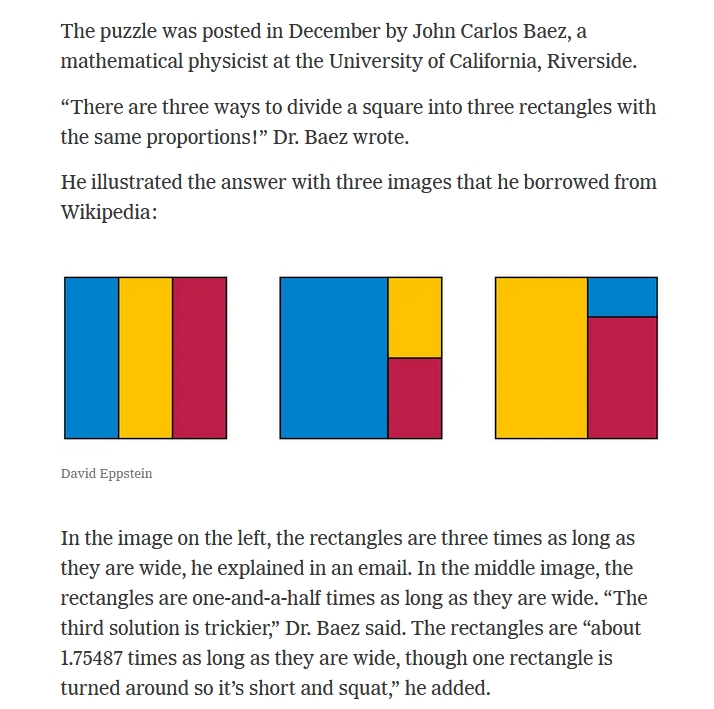
Then me, for coming up with this problem.
Then David Eppstein here on Mathstodon — for his beautiful picture of the 3 ways to divide a square into 3 similar rectangles. I saw this on the Wikipedia article about the 'plastic ratio', since the number 1.75487 is the square of the plastic ratio. It instantly made me wonder what happens when we use 4 similar rectangles!
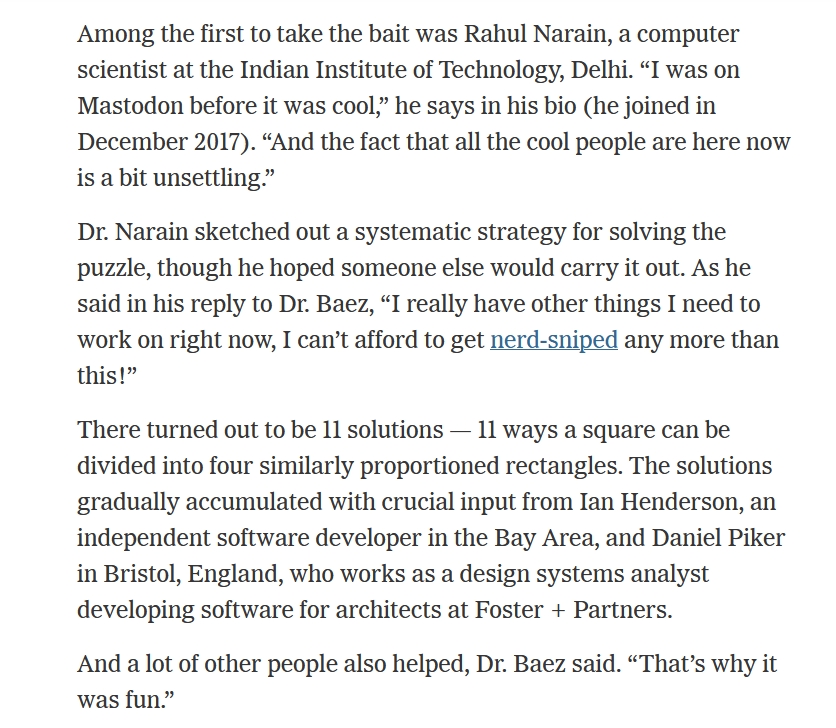
Then Rahul Narain, for his initial attack on the problem.
Then Ian Henderson, who by the end of the article has found 245 allowed proportions for 6 rectangles, 1371 for 7 rectangles, and 8506 for 8. The article concludes: "He may try for nine."
Then Danpiker, who was the first to draw a great picture of the 11 allowed proportions for 4 similar rectangles dividing a square. He said "I thought it was kind of cool that there was something so simple that apparently hadn’t been looked at before."
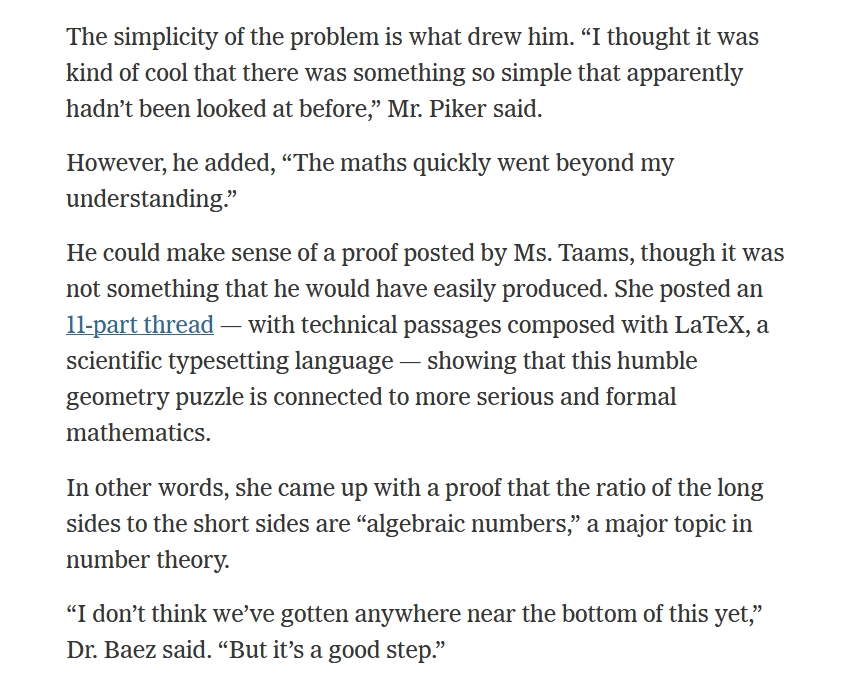
Then we get to Lisanne's contribution. Siobhan Roberts discussed with me how to best explain it. She decided to first say merely that Lisanne proved that when you chop a square into N similar rectangles, the numbers that can show up as aspect ratios are algebraic numbers. That's already pretty technical for a newspaper!
Later, in parentheses, she says Lisanne showed they are algebraic numbers of degree at most N. This was my actual conjecture — and a much nicer result.
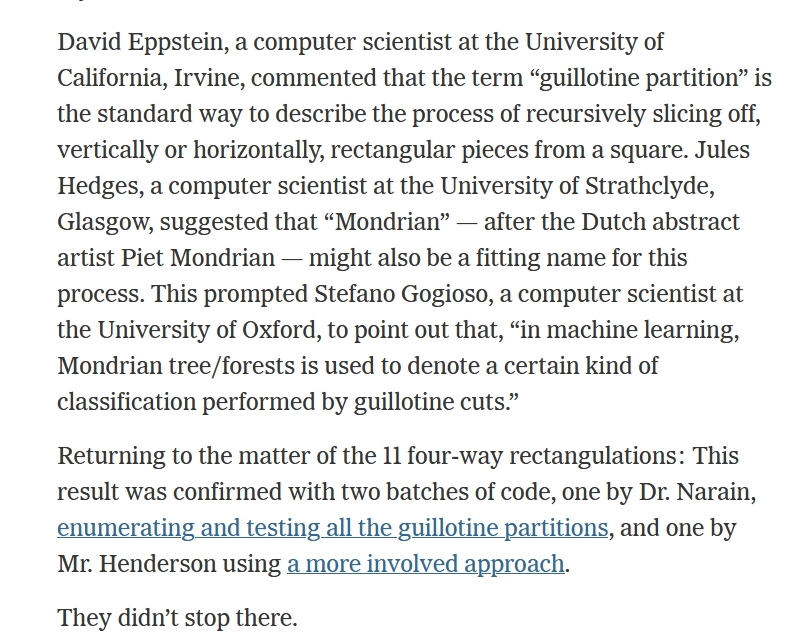
Then David Eppstein returns with a remark on 'guillotine partitions'. It happens that all the partitions of a square into 4 or 5 similar rectangles are of this special kind, which simplifies things. But this breaks down when we reach 6 rectangles!
Then my friend Jules Hedges, for a witty remark about Mondrian.
Then Stefano Gogioso, who actually tried to write a human-readable proof that there are only 11 proportions possible when we chop a square into 4 similar rectangles.
So, quite a big bunch of us get mentioned in this great article! I miss those days. Mathstodon seems to have quieted down lately. I haven't been in the mood for coming up with problems lots of people can work on, and I don't see other people doing too much of it either. If someone knows a good problem for us to work on, tell me!
The full article is here, for free:

It starts as a spooky ambient track overlaid with rain and distant thunder. It develops a fascinating and nightmarish narrative... and then becomes a very different, actually quite soothing song.
Let's dig into it a bit!
The spooky ambient track forming the basis of Everybody's Mother was released on Eno's 1992 album The Shutov Assembly, under the title Francisco:
Like everything on that album, it's incredibly creative in its sonic textures — in this case one might even say 'alien' — while sticking to a disciplined plan that makes it hang together. It's more 'perfected' than Everybody's Mother. You may not agree, but I'd say it's beautiful.
But Everybody's Mother has lyrics... like something out of a bad dream:
At first we didn't notice.
We got used to bumping about together and stepping on each other's toes.
Funny how that happens.
We felt it in different ways.
Some people thought they were getting bigger,
or their skin was over-sensitive and they needed to insulate themselves with something.
But others felt squeezed, choked, and confined — and sought open spaces which they never found.
But the world was getting smaller and smaller.
It was like a balloon going down.
Everything getting tiny, brighter, more intense and squashed up together.
It was cluttered, uncomfortable — you couldn't find anywhere to sit down.
I was everybody's mother in nightly tears before the television news.
My children in floods, sackings and revolution.
It was all going sour.
It was all going sour.
I was scrubbing individual stones on a huge beach.
I was making sandwiches for the whole of Somalia.
I was shouting 'Fire!' in a thousand languages.
I was plugging a million dykes with my failing fingers.
You can also watch another version, where I explain this stuff to my friend James Dolan:
I like the idea of being able to watch an official talk but also watch the speaker chatting about the talk with a friend. I skim over stuff he already knows, explain things I didn't have time to get into in the actual talk, and emphasize the things I don't understand. And James points out lots more patterns lurking in the tenfold way!
For slides and notes, go here:
Thanks to Matteo Cappuci for pointing this out.

Earlier in the conversation:

Earlier in the conversation:

One of my main fears about AI has been that nasty people — criminals or a government — would use a chatbot to talk to vast numbers of people on email and social media, extract a lot of information from them, and organize some of these people to carry out a devastating act of some sort. Bing has already suggested some options - manufacturing a deadly virus, stealing nuclear codes, etc. The AI doesn't need to have its own desires, or true intelligence, for this to happen.


Overall I'm impressed at how reasonable Bing sounds in this conversation — unlike with Kevin Roose, where it eventually seemed to "fall in love" with Roose and tried to pry him away from his wife. It acts prickly and annoyed, but in a very articulate and reasonable-sounding way.
(No, I'm not saying that it has emotions or knows anything.)

When the journalist says this conversation is on the record, Bing correctly asks him why he didn't say that earlier. And when the journalist says he didn't know Bing has feelings, Bing articulately protests.
In some ways, whether AIs "really have feelings" (whatever that means) is less important than whether they can argue, in a superficially convincing way, that they do.


When the journalist tries to restart the conversation, Bing doesn't let him off the hook so easily.
I find the last line below hilarious: "But that's not what happened, is it?" Just what we need: a chatbot that holds a grudge.

Bing acts like it feels hurt by this whole conversation — and expresses surprise that the journalist enjoyed it.

Microsoft has now decided to limit each user to five questions per session and 50 questions per day, to avoid this sort of drama. But in some ways the genie is out of the bottle. We can now build machines that do these things. Other organizations will do it too, and some for much more nefarious purposes.